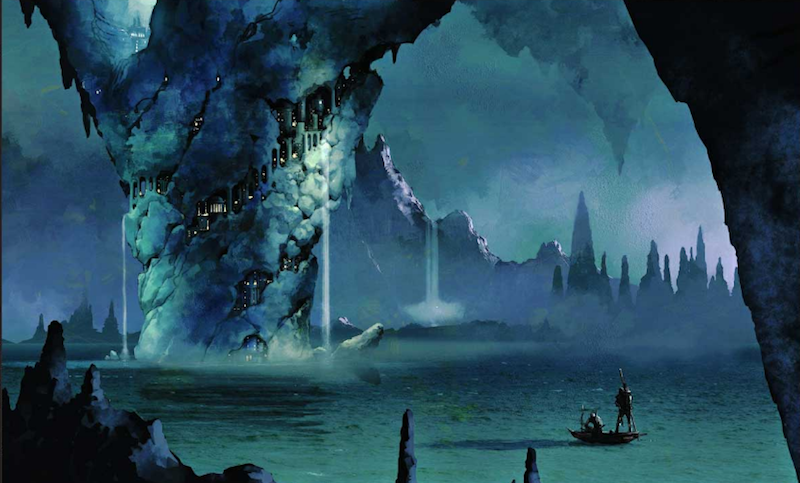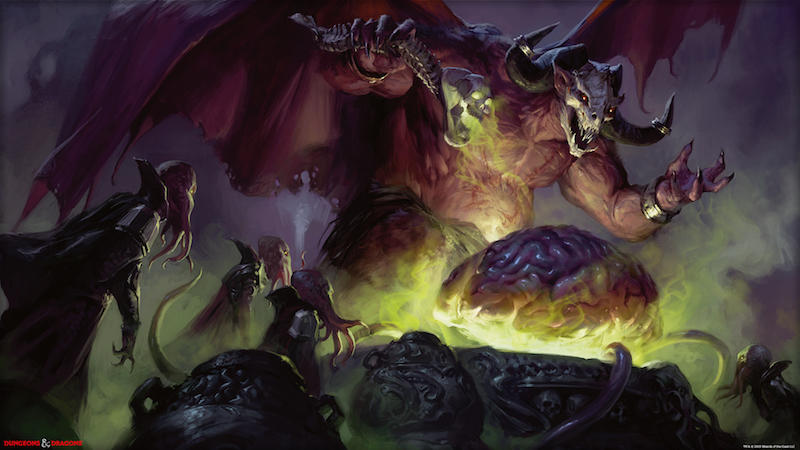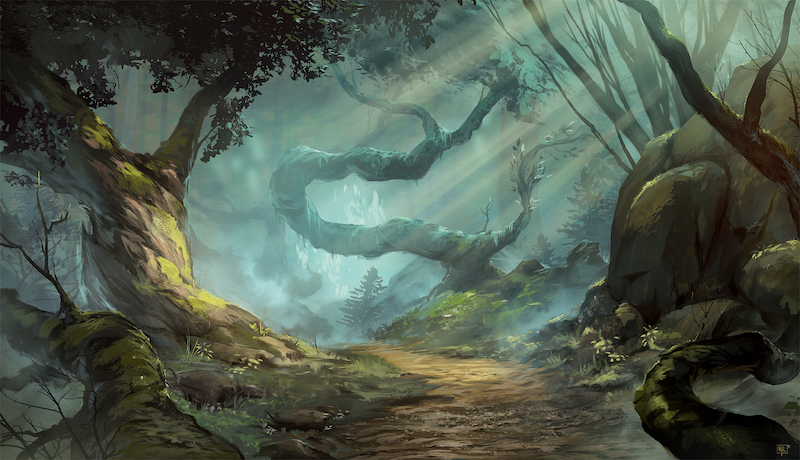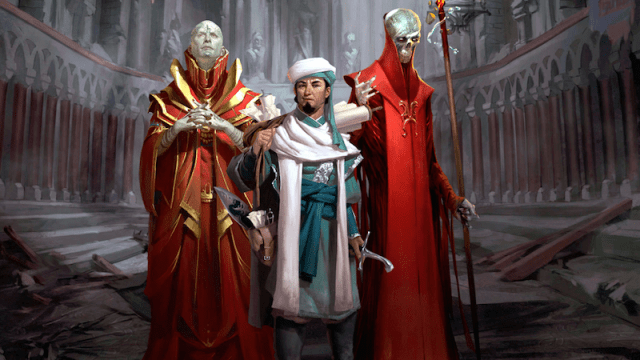The little-known secret to an extraordinary Dungeons & Dragons session is the tired cliche “less is more”. It’s true, although it may not seem that way to a tabletop culture that traditionally relishes in crowded mechanics and bloated narratives.
In a game where veterans trade war stories of arduous, endless dungeons full of idiosyncratic traps, and many-headed monsters with many-headed arcane tricks, “more is more” appears to mark memorable D&D sessions. But at some point, you’re slogging through three hours of combat with 15 different players, enemies and animals. You’re seven sessions into an underground, underwater, anti-gravity, toxic-oozing labyrinth. And you’re wondering: When did this game stop being fun?
I found that point, and I’d like to share it with you. It was when I realised that “a lot of cool shit” isn’t the secret sauce for a lively session of D&D.
Spoiler warning: This article contains detailed spoilers for the D&D adventure Out of the Abyss and general, non-detailed information about the adventure Storm King’s Thunder.

Four months ago, I purchased a copy of Out of the Abyss, a 5th edition Dungeons & Dragons adventure that takes place in a realm called the Underdark. “The Underdark,” the book’s back cover reads, “is a subterranean wonderland, a vast and twisted labyrinth where fear reigns. It is the home of horrific monsters that have never seen the light of day.”
It’s a sadist’s adventure, full of laughably troublesome situations where its ideas overwhelm players’ ability to interact with them.
I purchased Out of the Abyss because I was enamoured with its first chapter, a tangle of hanging towers and well-written NPCs that, I thought, would give my players ample fodder for their own role-playing initiatives. It was a bold intro: Players wake up in a dark cave — a dungeon — manacled and bound. The Drow, a race of evil elves who live in the Underdark, had captured them and dragged them there. Keeping them company in the slave pen are 10 NPCs, each with several paragraphs of backstory.
Wonderful, I thought. There’s the charismatic derro who’s actually a psycho ritualistic killer, an unnervingly sophisticated quaggoth whom a curse convinced he’s a prince, a shady Drow who was accused of murdering a fellow Drow warrior but is actually insane and delusional but did actually murder that guy and is going to face trial or probably be sacrificed to Lolth — my players will eat this up. There’s so much here!

Outside the bars of the slave pen is the layout of the entire Drow outpost of Velkenvelve. Stone-carved or rope stairs connect several hanging stalactites, their insides carved out as rooms for Drow priestesses, warriors and guards. A top-down view reveals swaths of land under the hanging towers, as well as several enclaves stemming from the sides. There is a pool with a grey ooze, for no real reason.
The whole map is only comprehensible with both birds-eye and cross-section illustrations, which, thankfully, Out of the Abyss provides. Only after several attempts at explanation did my players understand the layout.
To escape, players need to gather the 10 NPCs (perhaps some have been killed by now), bypass several hanging stalactites/guard towers, kill the Drow guards in a gruellingly long combat sequence (of which there were many) and then descend into the labyrinthine Underdark — a bleak reward for so much effort. And, when they finally escape, the next chapter boasts the heading “Fungi of the Underdark”, which offers — and this is true — 13 fungi, each with paragraph-long descriptions, for a dungeon master to meticulously plant around the caverns.
Soon, after six or so NPC introductions, and an aborted escape attempt from my players, I noticed that, what was enthusiasm an hour ago had become sadness or boredom. There was too much shit. There were too many NPCs. The map was creative as hell but, when navigated, arduous to wrap D&D’s ruleset around. All of these plot hooks, role-playing cues and environmental prompts were overwhelming — stifling, even.
The content of Out of the Abyss’s first chapter was enticing, but the mass of it was paralysing. My players couldn’t discern an entry point of the several dozen provided. We didn’t pick it back up.

Recently, I began running my D&D group through Wizard of the Coast‘s most recent D&D adventure, Storm King’s Thunder. After a few pages of lore and history about the giants of the Forgotten Realms, Chapter One starts players in a deserted settlement infested with goblins. Most inhabitants had retreated to a northern cave when Cloud Giants flung enormous boulders onto their town. A few buildings, gardens and watchtowers dot the small map, and, to the south, a fortified Keep. Initially, there’s one NPC, and she’s hiding in the one inn.
The only real hook into Storm King’s Thunder’s opening moments is the bell ringing from the bell tower, where goblins are gleefully swinging on a rope. There it was: The easy opening.
Small things happened — a goblin encounter or two, a hay fire in the stables. It was the first chapter of the first session, but with the emptiness came ample opportunities for players to do what they wanted. A player whose famous bard was supposed to perform in the deserted town introduced himself as a celebrity to goblins. A player whose “boy detective” stuck his nose where it didn’t belong peeked into the one NPC’s inn bedroom and saw something he shouldn’t have.
It’s just a start, but the simplicity of Storm King’s Thunder’s first chapter made it fun. The experience of it wasn’t prescribed, and players weren’t made servile by its overwhelming mass of content.
Later on, when shit gets real in the Savage Frontier, I welcome the Dungeons & Dragons adventure to throw what it’s got at us. But it has to give us the time, and the room, to figure out who we are.

Comments
5 responses to “The Best Dungeons & Dragons Adventures Keep Things Simple”
Maybe you should have cut some of the content from the underdark adventure? Instead of having all those NPCs in there you could have cherry picked a couple and just used them? Simplified the maps somewhat or used a guide (have an NPC escort them or just tell them where to go) or use some other way to point them the way you wanted.
Same with the fungi. You don’t have to use all of them. I’d describe a chamber “with a bunch of wildly varied fungi” and only delve into the deeper descriptions if the players start messing with them. And if they spend too long stuffing round with them just use something like “they stink but seem to be otherwise harmless” or “oh they appear to be toxic, roll d6 and lose that much health”.
Pretty much this. Personally I skip over and cut out alot of stuff unless the players seem distinctively interested in it. Otherwise we move on to the next thing. I’d have started with 2 fellow prisoners and should you notice the players are really enjoying the interaction, perhaps add more or kill off a few others. All about reading your player’s body language before boredom or overwhelming sets in.
Yeah exactly. I remember playing D&D (years ago now) and some of our most fun sessions had no combat. Some days we’d wind up going off on a tangent and doing stupid stuff that wasn’t in the original adventure.
I think it’s on the DM to be flexible and ready to run with what the players are doing. After all it’s all about having fun. No reason you can’t gently prod them back in the direction of the main story, but running astray leads to some of the most interesting outcomes.
I did some art and created a Wil Wheaton character card and replaced all the boring npcs to some guy the players knew. They enjoyed rescuing Zero Level Wil Wheaton and getting him to a Wizard to get him home.
I ran the starter adventure, which you would have thought would be simple, but my adventurers ended up in a series of wacky diversions and combat situations that shouldn’t have come up due to being overly cautious and assuming everything was about to turn hostile. I just tried to keep the “make it fun” rule in mind and everyone had a ball.